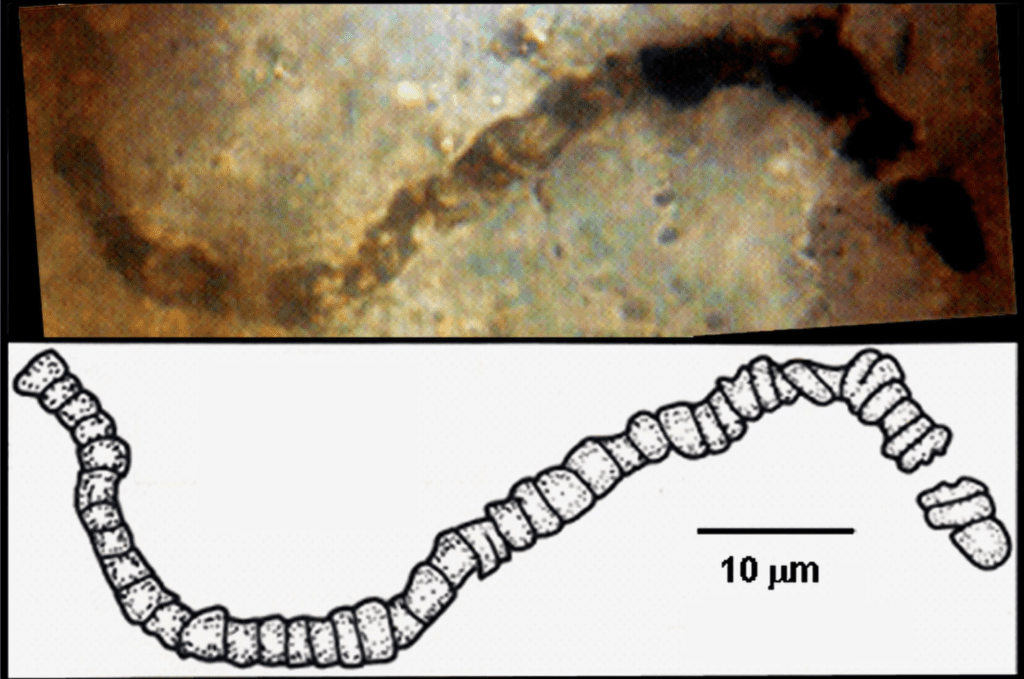The 3.5 billion-year-old carbon signatures left behind by ancient microbes could be the earliest evidence of life. Using novel tools and techniques, scientists established that the microfossils unearthed from western Australia were indeed organic in origin. The diversity of microbial species found in the volcanic rock not only suggests that life may have appeared earlier than thought but also ups the odds of finding alien life given the harsh environment.

One of the microfossils discovered in a rock sample from the Apex Chert. Credit: William Schopf, UCLA
The microfossils were first dug up in 1982 and formally described in 1993. It took almost 25 years before scientists could access the right technology that enabled them to study the tiny bits and pieces that look like they were overcooked.
Now, William Schopf, a professor of paleobiology at the University of California, Los Angeles, and colleagues, examined 11 microscopic specimens retrieved from the Australian ancient site using secondary ion mass spectrometry (SIMS). This method enabled the team to analyze the composition of the microfossils by bombarding them with ions, and then evaluating the ions that were ejected from the material.
The fossils had to be meticulously ground down micrometer by micrometer so the scanner could work. Ultimately, the procedure confirmed that the molecular signatures etched into the ancient rock “are characteristic of biology and metabolic function,” Valley said in the statement.
Previously, scientists had identified other microfossils of ancient microbial life such as hematite tubes found near Quebec, Canada, that are thought to be between 3.77 billion and 4.29 billion years old. Elsewhere, in Greenland, scientists discovered 3.7-billion-year-old microbial colonies trapped in sediment. Both of these examples are older than the Australian finding. What sets it apart, however, is that this study is the first to describe ancient fossilized microbes at the individual level. As such, these seem to be the best candidates for the earliest life forms that we know of, for the moment at least.
That’s if these microfossils are indeed former lifeforms and not the product of some geochemistry, as some critics have raised doubts.

J. William Schopf and colleagues from UCLA and the University of Wisconsin analyzed the microorganisms with cutting-edge technology called secondary ion mass spectroscopy. Credit: John Vande Wege/UCLA.
The diversity of the newly identified microbes is quite staggering considering their age. Some were primitive photosynthesizers, while others were producers and consumers of methane. When they were alive, the world these microbes called home looked radically different. Volcanic eruptions abounded and the planet was wrapped in a hazy atmosphere. Today’s oxygen-rich atmosphere would have been poisonous for most life forms. In the end, the photosynthetic organisms won, guiding life towards a new paradigm.
Some say that Saturn’s moon Titan is quite similar to early Earth in many respects, with its methane-rich lakes and methane-rich atmosphere. Perhaps, on a similar world or, why not, Titan itself, life forms resembling these very early Earthlings could be flourishing.
“This tells us life had to have begun substantially earlier and it confirms that it was not difficult for primitive life to form,” said Schopf in a statement about the research.
“[This study] confirms it is not difficult for primitive life to form and to evolve into more advanced microorganisms,” he explains.
It immediately follows, if Schopf is correct, that the odds of intelligent alien life forms being out there have also gone up.
“If the conditions are right, it looks like life in the universe should be widespread,” he said.
Findings appeared in the journal Proceedings of the National Academy of Sciences.









